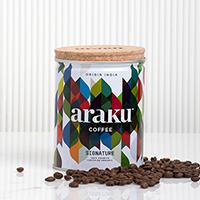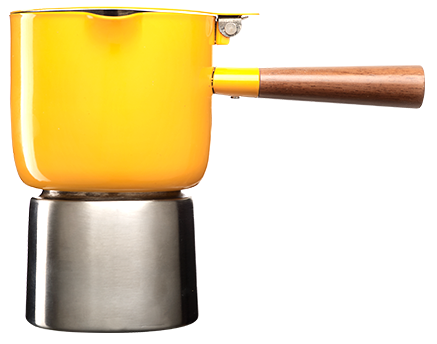GET 20% OFF
By subscribing to our newsletter
ALL YOU NEED TO KNOW ABOUT CREATING MICROFOAM

WHAT IS MICROFOAM?
Have you ever wondered what is special about the dense milk we love to cushion our caffe lattes with? How do Baristas create latte art masterpieces which look as delicious as they taste? The answer is Microfoam - exceptionally fine, dense milk bubbles, akin to liquid velvet. Viscous, thick & creamy, not too airy, and sweet. Properly steamed microfoam brings out the natural sweetness that milk offers without the overly sickly-sweet taint of too hot and scalded milk.
Technically speaking, proteins in milk are energized by introducing hot steam. These proteins become wrapped in air, times millions and as these air bubbles expand, so does the hot milk.
Dense bubbles of Microfoam and its texture like that of whipped cream is perfect for creating Latte Art. Free pour latte artists use the angle of the steam pitcher and wrist action while pouring to create Rosetta’s, hearts, swans and even peacocks in their designs. Sketching latte artists use pointed tools to draw into the milk and cream of the espresso to create animals, people, abstract designs and more. Sometimes, chocolate syrups or food coloring is added to create extra dimensions to the Microfoam milk in espresso.
GETTING YOUR LATTES JUST RIGHT
If you are in line at a café and see your barista steaming milk and hear a loud roar of the milk steaming, pass on that cuppa, for the milk has burned. Likewise, if a barista has allowed the milk pitcher to steam unattended, pass on that cuppa too. The milk is scalded, will no longer foam properly, and taste burnt as it loses its sweetness.
At our Roastery and ARAKU pop ups, we use commercial La Marzocco espresso machines to do the trick. The steam pressure of 9 bars is exactly right for our SCA trained brewers to create Microfoam. Filling the steam pitcher with cold fresh milk for each individual drink, the barista holds the steaming pitcher at a slight angle with the tip of the steam wand, JUST under the surface of the milk. This is followed by gently opening the steam valve to ensure the proper amount of steam is released into the milk. The milk creates a whirlpool motion as the proteins expand, followed by gently lowering the pitcher, always maintaining the steam wand tip just below the milk surface. In no time, the milk expands to express itself as the temperature rises. During this time, it is key to use all your senses - eyes, ears, smell, and touch. Eyes to watch the whirling motion of the milk and steam wand. Ears to listen to the pitch of the milk. (Too high a pitch indicates lack of steam pressure, too low a pitch or rumble like a jet plane is a sure way to tell if the milk is burned). The proper indicator is a shhh shhh or hissing sound. While steaming, a gentle touch of the steam pitcher indicates temperature. All senses matter.

Does this sound like a lot of science? If yes, we assure you it can be simple once you learn the techniques. Whether you are a Professional barista, home brewer or someone who enjoys savoring delicious coffee with milk, all senses come into play during preparation.
TREAT YOURSELF WITH SOME LATTE LOVE AT HOME
There are milk frothers and hand mixers - both electric and manual, readily available in the market which can create milk foam of varying degrees. You can also use an electric blender with warm milk. Please note it is not possible to use an Indian filter or stove top espresso machine for creating milk Microfoam. These brewers are for coffee only.

So here is our milk Microfoam hack if you have a French press coffee brewer at home. Cleanse the glass carafe and the screens thoroughly using a mild unscented soap and dry. Heat milk in a separate pan on the stovetop, be careful not to boil it. Pour hot milk into the carafe until half full of your press. (Notice our carafe, just like our glass, is always half full!). Place the lid with the plunger attached onto the carafe and pump several times, forcing hot milk through the screen multiple times. Be sure to brew your coffee first and set it aside because coffee can sit and stay warm for a few moments, milk Microfoam cannot. It will settle and separate quickly as the air pockets rise. This is why many cappuccinos become caffe lattes very quickly, but we will tackle that mystery for you in another blog.
So, can any milk be used to create Microfoam? A milk with higher protein content will produce better Microfoam. Milk alternatives such as soy and almond milk and even within brands have a variety of heat tolerances, so you will want to experiment to see what works best.
Remember, it is not just about looks. Equally important is how the Microfoam tastes. We feast first with our eyes before we begin to enjoy a meal. The same is true in beverages. How ARAKU specialty coffee lingers sip after sip with a pleasant texture and taste is the final note of quality in the cup. The last impression is equally important as the first. With ARAKU, let us ensure your first and lasting impression is a great one.
Show us your milk mustache with a smile @arakucoffeein



